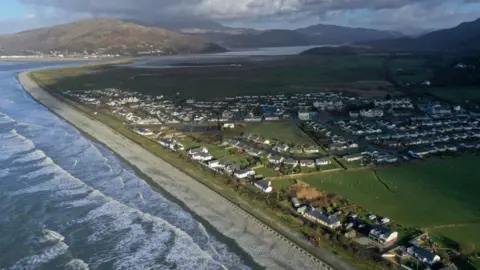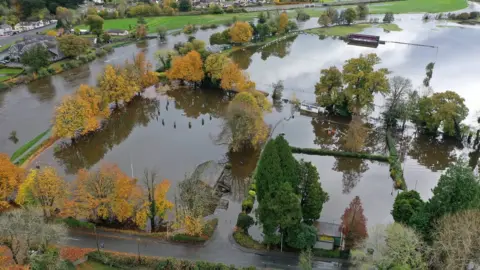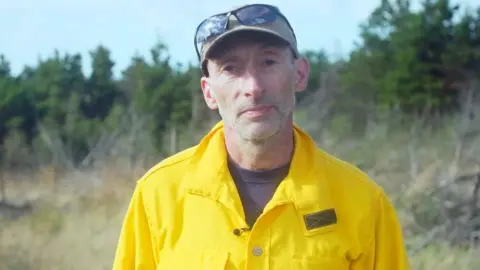Climate change: Droughts and fires 'may be features of Wales'
Abandoned coastal communities, forest fires and water shortages may become features of life in Wales later this century, scientists have warned.
Extreme weather events will threaten lives and make people poorer, they said.
Welsh academics working on climate change predictions have been speaking ahead of the COP26 summit in Glasgow.
But they insisted there was hope of avoiding the worst effects if action was taken globally.
World leaders will gather in Glasgow from Sunday to update plans to cut the greenhouse gases driving a dangerous rise in temperatures.
BBC Wales asked some of the country's leading researchers in this area to summarise what is at stake.
'A different world'

It will be like living "in a different world" if emissions do not fall dramatically over the next couple of decades, warned Prof Mary Gagen, of Swansea University.
Average annual temperatures have already increased by almost a degree since the 1970s and will edge closer to three degrees by 2100 "if nothing changes", the specialist in trees and climate change said.
"I find it really striking to think that for someone like me, in the middle of my life, I am never going to see a return to climate stability.
"And that's because we have a huge amount of warming already baked into the system."
 Getty Images
Getty ImagesStorms and sea levels rise
As a coastal nation, one of the biggest challenges for Wales is rising sea levels coupled with "increased storminess", explained Prof Tom Rippeth, of Bangor University's School of Ocean Sciences.
Infrastructure such as the A55 and railway line running along the north Wales coast are likely to be swamped more regularly, research by the school has shown.
"At the moment we're seeing something like 4cm of sea level rise per decade, but the big concern is if we see the major ice sheets across Greenland and the Arctic melt more rapidly," he said.
The loss of sea ice thousands of miles north of Wales could also be affecting our weather systems, according to another long-running Bangor study - bringing extreme wintry conditions such as 2018's Beast from the East.
On COP26, Prof Rippeth said "every one of these summits becomes more important, every one of them takes us that much closer to the last chance saloon".
 Lee McGrath
Lee McGrath'Profound emotional impact'
Areas along the coastline likely to suffer annual flooding from the sea later this century will "either be protected by new engineering works or will have been abandoned by people," according to Dr Hywel Griffiths of Aberystwyth University.
"That's going to have a profound impact, both psychologically and emotionally on us as citizens."
By the middle of the century "we're likely in Wales to see a country of greater extremes" and that would lead to more erosion, landslides and large-scale changes in our landscape, the geographer said.
 Getty Images
Getty ImagesWater shortages
"Wales is, of course, typically thought of as a country where water is plentiful," said Bangor University's Dr Prysor Williams.
But modelling he and colleagues at Trinity University Dublin have carried out showed "that situation may well change" in future.
Researchers simulated future daily streamflow for the Conwy and Tywi rivers - Wales' longest river - up to the year 2079, taking climate change predictions into account.
"We showed that there are likely to be prolonged periods where water is actually quite short in supply and obviously that has knock-on implications for a whole range of industries as well as wildlife too.
"Water stress might be something that we contend with a lot more often in future."
 Getty Images
Getty ImagesWildfires
With that comes the threat of wildfires and Wales is already one of the most badly affected parts of the UK.
South Wales suffers about 3,000 blazes a year on average and there is "great certainty this is going to get worse in the future with warming temperatures," explained world-leading expert Prof Stefan Doerr.

The increasing likelihood of extreme weather events - particularly long, dry periods - leading to fears grassland blazes could upgrade into forest fires in future.
"We have large stretches of forest plantations and once you have a forest burning it's almost impossible to put out," the Swansea University scientist said.
"In those cases the risk to the population is substantial."
'Real hope'
For Prof Gagen, the thought of how we are going to adapt is "really worrying".
"But I also have real hope that Wales is a country where we aim to look after future generations and the most important part of that is getting our climate back to a stable situation and bringing those emissions down to safer levels," she said.
Her message to those sitting around the negotiating tables at COP26 is "please stop thinking of your next election or five-year business plan".
"Your children and grandchildren are not going to take that as an excuse."



- BARGE BASHING AND BICKERING: Explore Welsh canals with Maureen and Gareth
- WONDERS OF THE CELTIC DEEP: Encounter mythical coasts and extraordinary creatures

